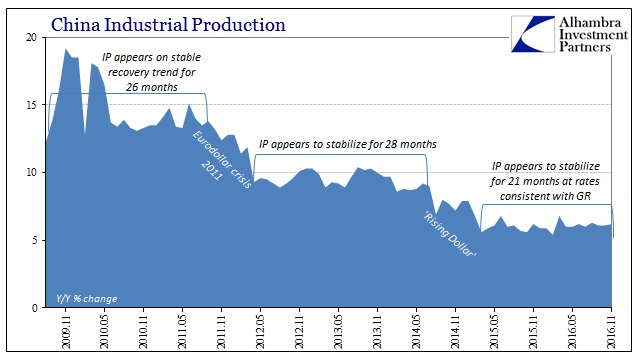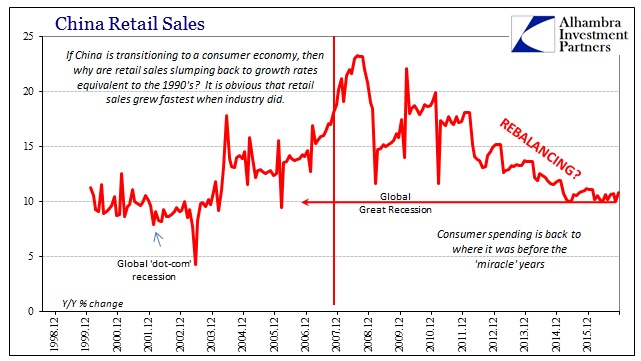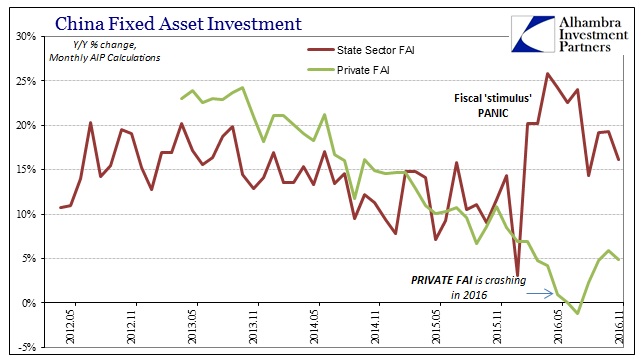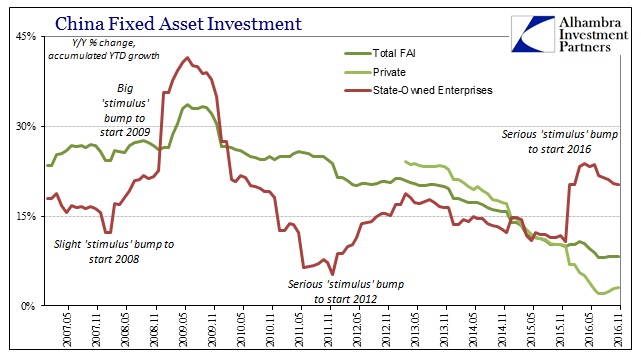Chinese industrial production, retail sales, and fixed asset investment were all taken as better or improving. Industrial production, for example, was 6.2% in November 2016, up from 6.1% in both September and October. Retail sales grew 10.8%, the best rate since December 2015. Fixed asset investment grew by an accumulated rate of 8.3% for the second straight month, better by a few tenths of a percent than the (so far) low point registered in July.
None of these statistics, however, are actually meaningfully improved. Instead, they suggest, as they have for years now, the same dragging global economy to which Chinese economic fortunes overall are tied. If anything has changed, it is how each of them is being interpreted. In terms of industrial production, that has literally been the case.

When industrial production first slowed (again) in late 2014, that was all shrugged off as “transitory” weakness related to the oil supply glut, in accordance with the mainstream assessments of pretty much everything at that time. That emphasis was pushed further particularly after February 2015 when the PBOC cut both rates and the reserve requirement. It was expected, generally speaking, that the Chinese industrial economy would join the US economy that was speeding toward the fruits of “full employment”, and that such PBOC “stimulus” would ensure that positive outcome.

After the events of August 2015 and then those late in last year, the hopeful scenario of “stimulus” gave way to outright fears of what might have been described as a “hard landing” in China. The IP statistic, as the other economic accounts, was no longer so easy to just set aside and was instead suddenly looked upon very differently.

The “hard landing” didn’t happen, of course, and now IP supposedly proves that the Chinese economy has stabilized in what is now described as the best case. If you look back closely through all of that, however, what you will see is that IP has been right around 6% the entire time. Going back to March 2015, Chinese industrial production has been between 5.9% and 6.3% in 15 of those 21 months. The average growth rate is 6.04%. Industrial production didn’t change over the past two years, the narrative of nearly the exact same rate month after month did.
Lost in the relief is that the Chinese economy, whether it has stabilized or not, is slower still than it was entering this questionable period. If you had proposed a stabilizing Chinese economy in the middle of 2014 it would have meant with IP at 9%, not 6%. And if you had done the same in 2010, as many policymakers and economists attempted, production would be growing at 13% not 9%. The Chinese economy, as the global economy, gets weaker not in a straight line but via clear, distinct episodes.

If industrial production is now stuck at 6%, that is a very negative development (setting aside all recently revived questions about the veracity and accuracy of Chinese statistics). In terms of retail sales, at 10.8% that is the best growth rate this year but only marginally so. Retail sales have, like IP, come to be stuck at a level of growth consistent with the Chinese economy from before its (eurodollar) “miracle.” That is a very different proposition than the one suggested by “rebalancing”, as the term itself is supposed to suggest an evolving economy pointing toward new avenues for growth rather than the devolution backward that is only visible here.

More important than retail sales or even industrial production is fixed asset investment. At one point earlier this year, private FAI (on a monthly basis) actually turned negative. It has since stabilized (there’s that word) but at a level that is consistent with big trouble. Private FAI is and has been the driving force in China’s urbanization, so again there is no meaningful difference between the 4.9% Y/Y rate in November 2016 and the -1.2% rate from July.

That is especially true as these near-zero rates follow already low rates from the year before. Fixed investment, private or in total, has been weak for several years now, and nothing like the 20-30% growth rates that were not just common before this latest “dollar” bout but the standard and baseline by which future economic and financial expectations were set.

There is a lot of positive commentary about how this is a positive sign that the Chinese economy isn’t getting worse when that assessment fails to account for just how much worse the Chinese economy had already become in a larger sense than the past few months – and all that despite more than a little “stimulus”, fiscal as well as targeted monetary. By every measure, the Chinese economy is either worse (retail sales, FAI) or even (IP) this year as compared to last year.
If last year was an otherwise very good year, then slowing to what we see in 2016 could be a viewed ambiguously. But, obviously, 2015 was not a good year, and overall it was cause for righteous and widespread concern. The global economy as it appears through China’s numbers still hasn’t changed; only the narrative has and really without any basis for it. If after all the “stimulus” the best the Chinese economy could manage was a repeat of 2015, in terms of industrial production, then there is by far a lot more to be worried about than to be hopeful for.
